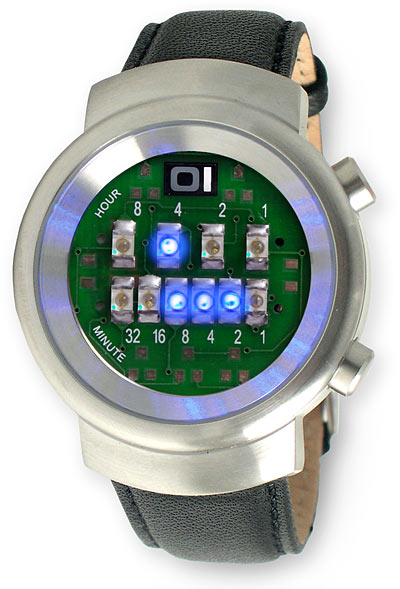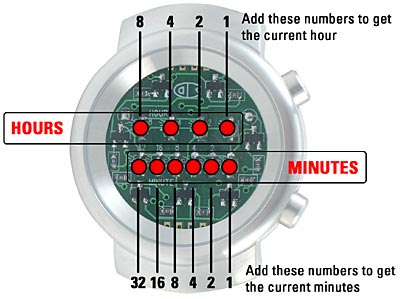Telling time precisely
On a binary watch, there are two rows of LEDs:

The top row displays the hour. The bottom row displays the minutes.
To tell time, sum each row:

The time displayed in the first picture is 4:14.
After a day or two of wearing the watch, it's easy to tell time. The patterns for the first twelve numbers in binary get memorized quickly.
For the minutes, shortcuts to add up the numbers start appearing. The most convenient three are 32 + 8 = 40; 16 + 4 = 20; and 8 + 2 = 10. Any two lit LEDs separated by a slot sum to a power of ten or five.
Somehow I've been a computer scientist for a decade, yet I'm just now seeing all these patterns.
Approximating time
Most often, however, I just need to quickly approximate the time as "on the hour," "quarter past," "half past," and "quarter 'til."
To estimate this quickly, the first two bits on the minute row are sufficient:
- 00 means roughly "on the hour."
- 01 means roughly "quarter past."
- 10 means roughly "half past."
- 11 means roughly "quarter 'til."
Thus, by glancing at the most-significant minute bit, the watch gives a quick "visual" approximation of the time. By glancing at two bits, it is accurate to within a quarter of an hour.
For quickly estimating time, it's also useful to round each minute LED to its nearest power of 5 and to look at the first 4 LEDs only; that is, treat the first LED as 30, the second as 15, the third as 10 and the fourth as 5. This trick is accurate to about five minutes.
Conclusion
It's a gimmick for getting attention, but it's not impractical.
And, depending on the time, it makes a good flashlight in the dark.